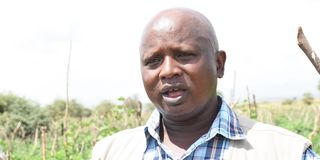NDMA appeals for food aid for Isiolo locals facing hunger

NDMA Isiolo Director Lordman Lekalkuli who has said that between 45 and 50 per cent of the county’s residents are facing acute hunger and need food aid.
More than 100,000 people in Isiolo County are facing hunger and need emergency food distribution, the National Drought Management Authority (NDMA) has said.
Reduced rainfall during last year’s October-December season, the Covid-19 pandemic and drying of boreholes and water pans that contributed to reduced yields has been blamed for the current situation which is at alert stage.
Isiolo County NDMA Coordinator Lordman Lekalkuli said between 45 and 50 per cent of the residents are in dire need of food aid.
Most affected
The most affected wards are Cherab, Oldonyiro, Chari, Sericho, Garbatulla and Burat.
Mr Lekalkuli warned that the situation could worsen with more people being affected if the long rains expected in April are not adequate.
But more worrying is reducing water levels in Ewaso Nyiro, Isiolo and Bisanadi rivers, which locals rely on for domestic water use and for irrigation purposes. The low water levels have resulted to rationing for residents, especially in populated Isiolo town and its environs.
According to NDMA, Residents in far flung areas are trekking for over 15 kilometres in search of pasture and water for domestic use and for their livestock.
Crop failure
“Most of the farmers incurred losses due to crop failure following reduced rainfall and the situation could worsen if the expected rain is not enough,” Mr Lekalkuli told the Nation.
A recent food security assessment by the Kenya Food Security Steering Group and the United Nations revealed that 238,000 people in Mandera, Isiolo, Wajir, Garissa, Marsabit, Samburu, Turkana and Tana River needed food aid.
At least 1.4 million Kenyans are facing acute hunger, twice the number reported in the country in 2020.
The dwindling pastures in Isiolo has seen the conditions of sheep and cattle deteriorate.
Sell livestock
Herders have been asked to sell their livestock, now that their body condition is good and can fetch good prices, so as to get money for food. They have been advised not to wait until the animals are emaciated.
“They (herders) should offload some of the animals now that they can fetch good prices in the market and remain with manageable ones to cushion themselves against the effects of drought,” said Mr Lekalkuli.
The NDMA official said in partnership with the county government, they have come up with a disaster response plan to guide in mitigation measures.
Among the interventions include water trucking services for schools and health facilities to ensure high levels of hygiene and to help prevent an outbreak of water borne diseases. NDMA will also sink boreholes to support residents in remote areas.
Mr Lekalkuli asked residents to use water sparingly and ensure none goes to waste.
To ensure regular supply of clean water for domestic and livestock use, NDMA is currently constructing a 26-kilometre pipeline in Cherab Ward which has been relying on water trucking during dry spells.
The NDMA official appealed to residents in agro-pastoral areas of Kinna, Burat, Biliqo and Malkagalla to venture into farming to increase productivity.





